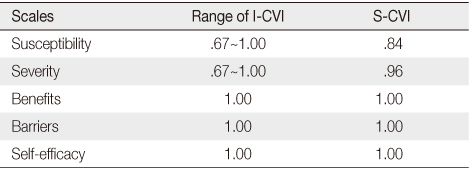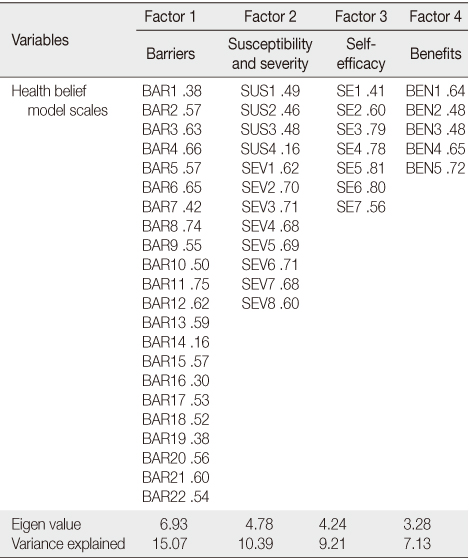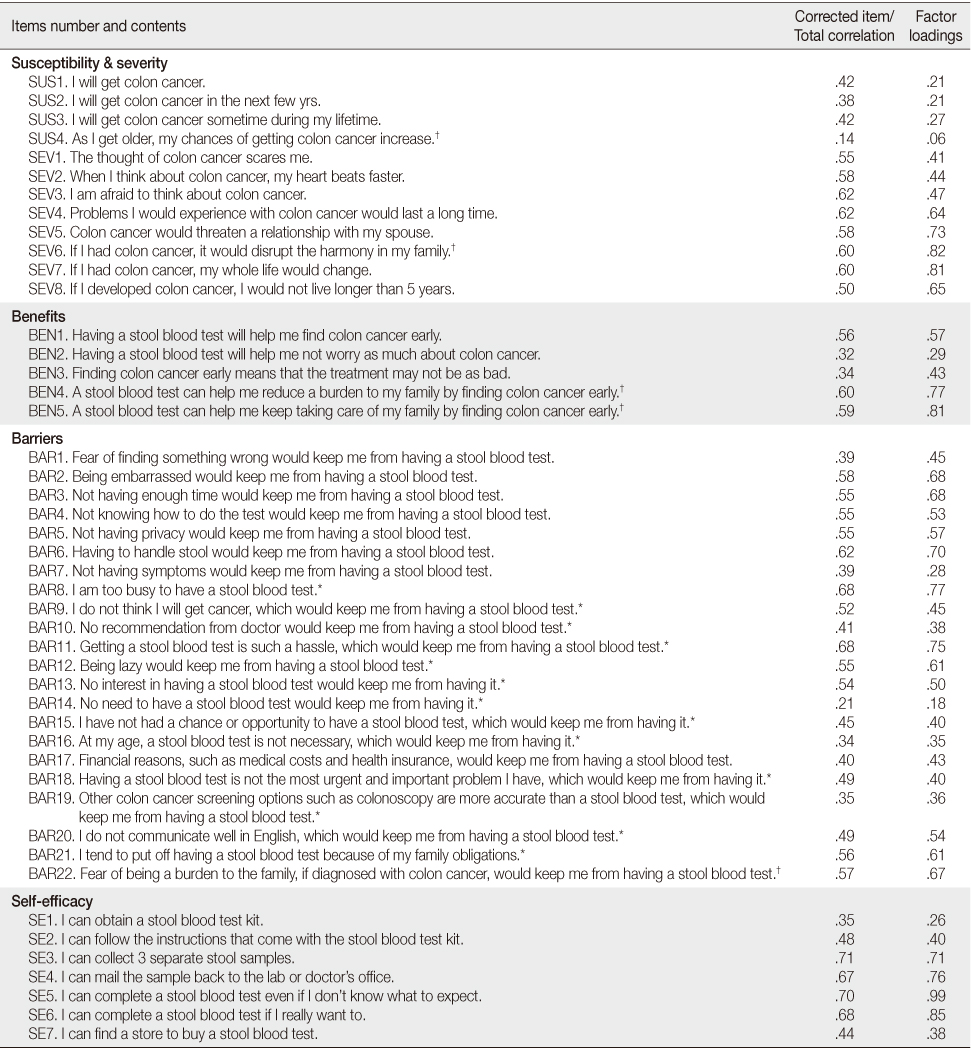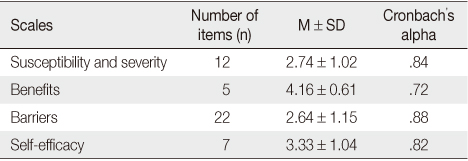Articles
- Page Path
- HOME > J Korean Acad Nurs > Volume 45(1); 2015 > Article
-
Original Article
- Cross-cultural Validation of Instruments Measuring Health Beliefs about Colorectal Cancer Screening among Korean Americans
- Shin-Young Lee, Eunice E. Lee
-
Journal of Korean Academy of Nursing 2015;45(1):129-138.
DOI: https://doi.org/10.4040/jkan.2015.45.1.129
Published online: February 27, 2015
1Department of Nursing, Chosun University, Gwangju, Korea.
2School of Nursing, University of California, Los Angeles, LA, USA.
- Address reprint requests to: Lee, Shin-Young. Department of Nursing, Chosun University, 309 Pilmun-daero, Dong-gu, Gwangju 501-759, Korea. Tel: +82-10-3069-7027, Fax: +82-62-230-6329, shinyoung0114@gmail.com
© 2015 Korean Society of Nursing Science
This is an Open Access article distributed under the terms of the Creative Commons Attribution NoDerivs License. (http://creativecommons.org/licenses/by-nd/4.0/) If the original work is properly cited and retained without any modification or reproduction, it can be used and re-distributed in any format and medium.
Abstract
-
Purpose
- The purpose of this study was to report the instrument modification and validation processes to make existing health belief model scales culturally appropriate for Korean Americans (KAs) regarding colorectal cancer (CRC) screening utilization.
-
Methods
- Instrument translation, individual interviews using cognitive interviewing, and expert reviews were conducted during the instrument modification phase, and a pilot test and a cross-sectional survey were conducted during the instrument validation phase. Data analyses of the cross-sectional survey included internal consistency and construct validity using exploratory and confirmatory factor analysis.
-
Results
- The main issues identified during the instrument modification phase were (a) cultural and linguistic translation issues and (b) newly developed items reflecting Korean cultural barriers. Cross-sectional survey analyses during the instrument validation phase revealed that all scales demonstrate good internal consistency reliability (Cronbach's alpha=.72~.88). Exploratory factor analysis showed that susceptibility and severity loaded on the same factor, which may indicate a threat variable. Items with low factor loadings in the confirmatory factor analysis may relate to (a) lack of knowledge about fecal occult blood testing and (b) multiple dimensions of the subscales.
-
Conclusion
- Methodological, sequential processes of instrument modification and validation, including translation, individual interviews, expert reviews, pilot testing and a cross-sectional survey, were provided in this study. The findings indicate that existing instruments need to be examined for CRC screening research involving KAs.
INTRODUCTION
METHODS
1) Step 1: Translation of the measures
2) Step 2: Individual interviews using cognitive interviewing
3) Step 3: Expert reviews
4) Step 4: Pilot test
5) Step 5. A cross-sectional survey
RESULTS
DISCUSSION
CONCLUSION
This manuscript is an addition based on the first author's doctoral dissertation from University of Illinois at Chicago.
This study was supported by research fund from Chosun University, 2014.
- 1. Gomez SL, Noone AM, Lichtensztajn DY, Scoppa S, Gibson JT, Liu L, et al. Cancer incidence trends among Asian American populations in the United States, 1990-2008. J Natl Cancer Inst. 2013;105(15):1096–1110. ArticlePubMedPMC
- 2. American Cancer Society. Colorectal cancer facts & figures 2014-2016. Atlanta, GA: Author; 2014.
- 3. Lee HY, Lundquist M, Ju E, Luo X, Townsend A. Colorectal cancer screening disparities in Asian Americans and Pacific Islanders: Which groups are most vulnerable? Ethn Health. 2011;16(6):501–518. ArticlePubMed
- 4. Maxwell AE, Crespi CM. Trends in colorectal cancer screening utilization among ethnic groups in California: Are we closing the gap? Cancer Epidemiol Biomarkers Prev. 2009;18(3):752–759. ArticlePubMedPMCPDF
- 5. Lee HY, Im H. Colorectal cancer screening among Korean American immigrants: Unraveling the influence of culture. J Health Care Poor Underserved. 2013;24(2):579–598. ArticlePubMed
- 6. Jo AM, Maxwell AE, Wong WK, Bastani R. Colorectal cancer screening among underserved Korean Americans in Los Angeles County. J Immigr Minor Health. 2008;10(2):119–126. ArticlePubMedPMCPDF
- 7. Sanders Thompson VL. Cultural context and modification of behavior change theory. Health Educ Behav. 2009;36:5 Suppl. 156S–160S.ArticlePubMedPDF
- 8. van de Vijver FJR, Leung K. Methods and data analysis for cross-cultural research. Thousand Oaks, CA: SAGE Publications; 1997.
- 9. Lee EE, Fogg L, Menon U. Knowledge and beliefs related to cervical cancer and screening among Korean American women. West J Nurs Res. 2008;30(8):960–974. ArticlePubMedPMCPDF
- 10. In: Becker MH. editor. The health belief model and personal health behavior. Thorofare, NJ: C. B. Slack; 1974.
- 11. Willis GB. Cognitive interviewing: A tool for improving questionnaire design. Thousand Oaks, CA: SAGE Publications; 2005.
- 12. Kline RB. Principles and practice of structural equation modeling. 2nd ed. New York, NY: Guilford; 2005.
- 13. Menon U, Champion VL, Larkin GN, Zollinger TW, Gerde PM, Vernon SW. Beliefs associated with fecal occult blood test and colonoscopy use at a worksite colon cancer screening program. J Occup Environ Med. 2003;45(8):891–898. ArticlePubMedPMC
- 14. Champion VL. Instrument refinement for breast cancer screening behaviors. Nurs Res. 1993;42(3):139–143.ArticlePubMed
- 15. United States Census Bureau. Place of birth by citizenship status. Universe: Total population 2006-2010 American Community Survey selected population tables. Washington, DC, Author. 2010;cited 2013 February 21. Available from: http://factfinder.census.gov/faces/tableservices/jsf/pages/productview.xhtml?pid=ACS_10_SF4_B05002&prodType=table
- 16. Lee SY, Lee EE. Korean Americans’ beliefs about colorectal cancer screening. Asian Nurs Res (Korean Soc Nurs Sci). 2013;7(2):45–52. ArticlePubMed
- 17. Polit DF, Beck CT. The content validity index: Are you sure you know what’s being reported? Critique and recommendations. Res Nurs Health. 2006;29(5):489–497. ArticlePubMed
- 18. SPSS Inc. SPSS 18.0 for windows. Chicago, IL: Author; 2009.
- 19. Arbuckle JL. AMOS 18: User's guide. Chicago, IL: SPSS Inc.; 2009.
- 20. Ullman JB. Structural equation modeling. In: Tabachnick BG, Fidell LS, editors. Using multivariate statistics. 4th ed. Boston, MA: Allyn & Bacon; 2001. p. 653–771.
- 21. Nunnally JC. Psychometric theory. 2nd ed. New York, NY: McGraw Hill; 1978.
- 22. DeVellis RF. Scale development: Theory and applications. Newbury Park, CA: SAGE Publications; 1991.
- 23. Chan YK. Privacy in the family: Its hierarchical and asymmetric nature. J Comp Fam Stud. 2000;31(1):1–17.Article
- 24. Beaton DE, Bombardier C, Guillemin F, Ferraz MB. Guidelines for the process of cross-cultural adaptation of self-report measures. Spine (Phila Pa 1976). 2000;25(24):3186–3191.ArticlePubMed
- 25. Champion VL. Revised susceptibility, benefits, and barriers scale for mammography screening. Res Nurs Health. 1999;22(4):341–348.ArticlePubMed
- 26. Lee SH, Ham EM. The relationship between the optimistic bias about cancer and cancer preventive behavior of the Korean, Chinese, American, and Japanese adult residing in Korea. J Korean Acad Nurs. 2010;40(1):52–59. ArticlePubMed
- 27. Champion VL. Development of a benefits and barriers scale for mammography utilization. Cancer Nurs. 1995;18(1):53–59.ArticlePubMed
- 28. Rawl S, Champion V, Menon U, Loehrer PJ, Vance GH, Skinner CS. Validation of scales to measure benefits of and barriers to colorectal cancer screening. J Psychosoc Oncol. 2001;19(3-4):47–63. Article
- 29. Maxwell AE, Bastani R, Warda US. Demographic predictors of cancer screening among Filipino and Korean immigrants in the United States. Am J Prev Med. 2000;18(1):62–68. ArticlePubMed
- 30. Kandula NR, Wen M, Jacobs EA, Lauderdale DS. Low rates of colorectal, cervical, and breast cancer screening in Asian Americans compared with non-Hispanic whites: Cultural influences or access to care? Cancer. 2006;107(1):184–192. ArticlePubMed
REFERENCES
Figure & Data
REFERENCES
Citations

- Influencing factors of colonoscopy screening in first-degree relatives of hospitalized colorectal cancer patients and preliminary clinical practices to improve the compliance
Dongqin Zhao, Fan He, Chen Luo, Huanhuan Huang, Qinghua Zhao
Frontiers in Oncology.2025;[Epub] CrossRef - Validity and reliability of the Turkish version of the health belief model scale for colorectal cancer screening
Ferdane Koçoğlu, Mesut Teleş, Semra Kocaöz
BMC Public Health.2025;[Epub] CrossRef - Predictive factors based on the health belief model on cancer screening behaviour in first degree relatives of patients with Lynch syndrome-associated colorectal cancer
Jiaojiao Gu, Shumin Jia, Huaxiang Chao, Tinglan Chen, Xiaodan Wu
International Journal of Nursing Sciences.2023; 10(2): 251. CrossRef - Perceived barriers and benefits in the participation in faecal occult blood test colorectal cancer screening programme
Martín Menéndez Rodríguez, Natalia García-Morales, Teresa Seoane Pillado, Jorge Garau Ramírez, Alba Traver Salvador, Yésica Hervás Jiménez, Noel Pin Vieito, Luis Menéndez Rodríguez, Joaquín Cubiella
Gastroenterología y Hepatología.2023; 46(3): 185. CrossRef - Perceived barriers and benefits in the participation in faecal occult blood test colorectal cancer screening programme
Martín Menéndez Rodríguez, Natalia García-Morales, Teresa Seoane Pillado, Jorge Garau Ramírez, Alba Traver Salvador, Yésica Hervás Jiménez, Noel Pin Vieito, Luis Menéndez Rodríguez, Joaquín Cubiella
Gastroenterología y Hepatología (English Edition).2023; 46(3): 185. CrossRef - Validación al castellano del cuestionario Rawl de cribado de cáncer colorrectal con sangre oculta en heces
Martín Menéndez Rodríguez, Jorge Garau Ramírez, Alba Traver Salvador, Yésica Hervás Jiménez, Natalia García Morales, Teresa Seoane Pillado, Noel Pin Vieito, Pablo Vega Villaamil, Agustín Montes Martínez, Joaquín Cubiella
Gastroenterología y Hepatología.2022; 45(2): 106. CrossRef - Rawl’s questionnaire Spanish validation for colorectal cancer screening with faecal occult blood testing
Martín Menéndez Rodríguez, Jorge Garau Ramírez, Alba Traver Salvador, Yésica Hervás Jiménez, Natalia García Morales, Teresa Seoane Pillado, Noel Pin Vieito, Pablo Vega Villaamil, Agustín Montes Martínez, Joaquín Cubiella
Gastroenterología y Hepatología (English Edition).2022; 45(2): 106. CrossRef - Cross-Cultural Instrument Adaptation and Validation of Health Beliefs About Cancer Screening
Fang Lei, Wei-Ti Chen, Mary-Lynn Brecht, Zuo-Feng Zhang, Eunice Lee
Cancer Nursing.2022; 45(5): 387. CrossRef - Effect of Health Belief Model on the Participation in FOBT CRC Screening Programme: Case/Control Study
Martín Menéndez, Natalia García-Morales, Teresa Seoane Pillado, Jorge Garau Ramírez, Alba Traver Salvador, Yésica Hervás Jiménez, Noel Pin Vieito, Luis Menéndez Rodríguez, Joaquín Cubiella
SSRN Electronic Journal .2021;[Epub] CrossRef - Cross-Cultural Modification Strategies for Instruments Measuring Health Beliefs About Cancer Screening: Systematic Review
Fang Lei, Eunice Lee
JMIR Cancer.2021; 7(4): e28393. CrossRef - Adaptation and validation of the health belief model scale for colorectal cancer screening
Shin‐Young Lee, Eunice E. Lee, Young Sun Rhee, Eun Young Yang, Jeong Ha Shin, Seonah Lee
Nursing & Health Sciences.2020; 22(2): 355. CrossRef - Enriching the quality of cross‐cultural instrument development through cognitive interviewing: Implications for nursing research
Min Kyeong Jang, Sue Kim, Eileen G. Collins, Lauretta T. Quinn, Chang G. Park, Carol E. Ferrans
Japan Journal of Nursing Science.2020;[Epub] CrossRef - Validation of Family Management Measure for the Brazilian culture
Regina Szylit Bousso, Carolliny Rossi de Faria Ichikawa, Maira Deguer Misko, Maiara Rodrigues dos Santos, Michelle Freire Baliza, Ana Márcia Chiaradia Mendes-Castillo, Estela Regina Ferraz Bianchi
Revista Brasileira de Enfermagem.2017; 70(6): 1151. CrossRef
Individual Interview Guide for Discussion of Health Belief Concepts
Ratings of Each Scale Item by Three Experts
I-CVI=Item-level content validity index; S-CVI=Scale-level content validity index.
Rotated Factor Analysis of the Health Belief Model Scales in Exploratory Factor Analysis
BAR=Barrier; SUS=Susceptibility; SEV=Severity; SE=Self-efficacy; BEN=Benefit.
Factor Analysis of Modified Health Belief Model Scales in Confirmatory Factor Analysis
SUS=Susceptibility; SEV=Severity; BEN=Benefit; BAR=Barrier; SE=Self-efficacy; *Items were developed by the PI based on findings from the individual interviews; †Items were adapted or developed by the PI based on the literature and then confirmed by participants during the individual interviews.
Internal Consistency Reliability
I-CVI=Item-level content validity index; S-CVI=Scale-level content validity index.
BAR=Barrier; SUS=Susceptibility; SEV=Severity; SE=Self-efficacy; BEN=Benefit.
SUS=Susceptibility; SEV=Severity; BEN=Benefit; BAR=Barrier; SE=Self-efficacy; *Items were developed by the PI based on findings from the individual interviews; †Items were adapted or developed by the PI based on the literature and then confirmed by participants during the individual interviews.
 KSNS
KSNS
 E-SUBMISSION
E-SUBMISSION





 Cite
Cite

